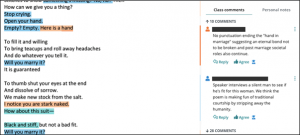In this guest post, Aimee Merrydew, a Curriculum Developer at Keele University, shares her experiences and reflections on teaching using a collaborative annotation approach in the School of English there. We hope that you enjoy the post!
I spend a lot of my time helping students to understand the differences between reading texts for fun and reading them for academic purposes. The need to teach students how to read as academics became even more apparent during the emergency transition to remote learning in early 2020, when I was teaching a first-year core module in the School of English at Keele University.
I noticed students weren’t reading as deeply, critically, or confidently as they were during our on-campus seminars pre-lockdown, where they would typically gather in small groups to annotate hardcopies of primary texts together. How could we re-create this active and collaborative reading experience in an online setting? This question preoccupied my mind for many weeks while I tried to adapt to this new way of teaching and learning with the students on the module.
I found one possible solution to this question in July 2020 while working as part of the History UK Pandemic Pedagogy team: collaborative annotation activities using Talis Elevate. I was introduced to this digital tool by Professor Jamie Wood (University of Lincoln) and adopted it in my teaching soon after, an opportunity that the students and I embraced with much eagerness and curiosity.
Collaborative annotation using Talis Elevate
Talis Elevate allows educators to upload text, image, and video-based resources for students to annotate collaboratively, meaning they can read and respond to one another’s comments on shared sources. Collaborative annotation tools are often used to facilitate asynchronous reading activities, but I primarily employed it in the module as a tool to develop students’ critical reading skills during synchronous seminars on Teams.
The source texts and activities varied week-by-week, ranging from close readings of poetry and plays, peer reviews of anonymous student essays, and critical analysis of articles and videos. While the sources and exercises changed, I intentionally kept the format the same so that students became familiar with the tool and how to use it with peers for their learning. The format was as follows:
- Students were assigned into small groups (3–4 people) via breakout rooms in MS Teams, where they read and annotated sources using Talis Elevate and question prompts.
- They were asked to appoint a designated annotator, who was responsible for sharing the group’s answers to the questions as annotations on the sources.
- After approximately 20 minutes, the groups returned to the main Teams room to discuss and debate each other’s annotations.

Outcomes and benefits:
These collaborative annotation activities have proven effective for helping students to build their reading literacies, not least in terms of boosting their confidence in reading for academic purposes (Cohn 2019; Wood et al. 2021; Merrydew 2021; Saville 2021). Students echoed these observations in their feedback, maintaining that frequent collaborative annotation activities:
- Provided regular opportunities to practise and gain feedback on their critical analysis, helping them to develop their academic reading literacies in preparation for their assessments.
- Enabled students to expand their knowledge by reading their peers’ annotations, introducing them to new and diverse perspectives on the subject matter.
- Allowed students to think through their ideas and share them as written annotations, empowering quieter students to share their interpretations and enriching conversations by bringing more voices into our conversations.
- Encouraged students to draw on and develop each other’s annotations, boosting their confidence by enabling them to validate their ideas and offer additional perspectives to aid knowledge development.
The COVID-19 pandemic has presented many challenges for educators and students across the world. Yet, as the above feedback demonstrates, it also created opportunities to rethink our approaches to building students’ academic reading skills through collaborative annotation activities, using digital tools such as Talis Elevate, Hypothes.is, Perusall, VoiceThread, and Google Docs, among others.
Of course, collaborative annotation technology existed long before COVID-19 and can be used in many more ways than I have mentioned here. I look forward to continuing my reflections on past uses of Talis Elevate and exploring new activities with students. More than anything, it’s been wonderful to watch students grow in confidence as academic readers and see them enjoy reading critically through collaborative annotation activities. Reading for academic purposes, as it turns out, can be fun. I’m excited to co-create further opportunities for students to develop these core skills and discover the joy of academic reading in the future.
You can read more about Aimee’s work in this area in her recent article:
- Merrydew, A. (2021) Reading literature: Critical pedagogies and Talis Elevate in online learning communities, Journal of Academic Development and Education 13, pp. 9–20.